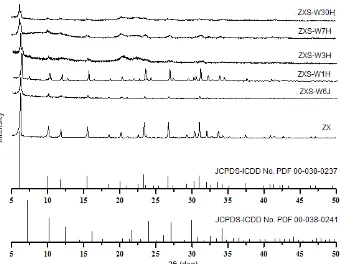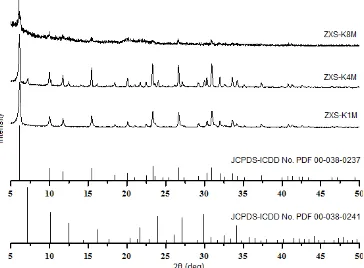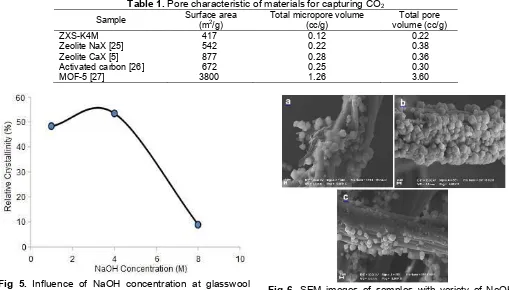Synthesis of Zeolite-X Supported On Glasswool for CO
2Capture Material:
Variation of Immersion Time and NaOH Concentration at Glasswool Activation
Anggita R.K. Wardani and Nurul Widiastuti
*Department of Chemistry, Sepuluh Nopember Institute of Technology (ITS) Jl. Arief Rahman Hakim, Sukolilo, Surabaya 60111, Indonesia
Received November 11, 2014; Accepted May 13, 2015
ABSTRACT
Zeolite X supported on fiber material (glasswool) was successfully synthesized using a simple hydrothermal method. Variation of immersion time and NaOH concentration were used for glasswool activation. Activation process of glasswool has effects toward crystallinity and growth of zeolite X on glasswool surface. The results of characterization using XRD, SEM and AFM showed that zeolite X crystal grew on glasswool surface with high crystallinity using NaOH concentration 4M for 24 h. BET surface area and pore characteristics were analyzed by N2 isothermal adsorption. Carbon dioxide adsorption measurement using gravimetric method showed that zeolite X supported on glasswool has capability to capture carbon dioxide at room temperature up to 2.83 weight %.
Keywords:zeolite X; glasswool; adsorption; carbon dioxide
ABSTRAK
Zeolit X berpendukung material serat (glasswool) berhasil disintesis menggunakan metode hidrotermal sederhana. Variasi waktu perendaman dan konsentrasi NaOH digunakan pada aktivasi serat. Proses aktivasi glasswool memberikan pengaruh terhadap kristalinitas dan pertumbuhan kristal zeolit X pada permukaan serat. Hasil karakterisasi XRD, SEM dan AFM menunjukkan bahwa kristal zeolit X dapat tumbuh menyelimuti permukaan serat dengan kristalinitas tinggi, menggunakan konsentrasi NaOH 4M selama 24 jam. Luas permukaan BET dan karakteristik pori dianalisis menggunakan adsorpsi isotherm gas N2. Pengukuran adsorpsi karbon dioksida secara gravimetri menunjukkan bahwa zeolit X berpendukung material serat mampu menangkap gas karbon dioksida pada suhu ruang hingga mencapai 2,83% berat.
Kata Kunci:zeolit X; glasswool; adsorpsi; karbon dioksida
INTRODUCTION
Carbon dioxide is considered to be the main trigger of the greenhouse effect that causes global warming phenomenon. This is indicated by a climate shift, increasing of earth temperature and rise of sea level [1-3]. Most of the carbon dioxide gases in the earth is the result of fossil fuel burning, because almost 85% of the world energy demand derived from fossil fuel [2]. These problems must be resolved to suppress the amount of carbon dioxide that released into the atmosphere, so the effect of global warming can be reduced.
One of the methods that can be used to overcome the problem of carbon dioxide gases is carbon dioxide capture technologies. Several methods are used to capture CO2such as absorption using chemical solvents [4-5], cryogenic, membrane [6] and adsorption of porous material [7-9]. Among all these methods, adsorption method has more advantages such as high selectivity to CO2 and has low desorption energy. Therefore, this
research is using adsorption of porous material method for CO2capture.
One of the carbon dioxide capture material that attracted the attention of researchers is zeolite. This material has been reported to have relatively high CO2 adsorption capacity at 25 °C conditions and relatively low pressure [7,9-10]. Zeolite is a crystalline material consisting of aluminosilicate that forms a cage-like pore structure with a molecular size of 0.5-1.2 nm. Zeolite crystal has the ability to form zeolite framework with variety pore sizes, so it can be used as a CO2 capture material [11-12].
Indones. J. Chem., 2016, 16 (1), 1 - 7
2
Zeolite X has powder form with relatively small particle size and difficult to separate. As a result, it often converted into pellets or granules by adding adhesive. However, that method can reduce the ability of zeolite for gas adsorption [16]. Another way that can be used to solve the problem of zeolite X powder form is by adding supporting material such as fibers. The fiber material has many advantages because it has a long filament that easily formed and it does not require adhesive [17]. In previous research glasswool was used as a support material in the synthesis of zeolite-A. According to the research [18-19], the concentration of NaOH solution used for fiber immersion can affect the crystallinity of zeolite attached to the surface of the supporting material. Therefore, further studies are necessary to determine the effect of activation conditions of the fiber toward zeolite crystal that attach to the surface of the fiber.
In this research, zeolite X synthesized with adding fiber support material. The type of fiber material that used in this study is glasswool with the added amount of 0.024 wt.% of starting materials. Variation of immersion time and concentration of NaOH in the fiber activation were used to determine its effect on synthesis zeolite X on fiber. Adsorption of carbon dioxide at room temperature to determine the carbon dioxide adsorption capacity of zeolite X supported on fiber material.
EXPERIMENTAL SECTION
Materials
Sodium aluminate (anhydrous, Sigma-Aldrich), sodium silicate solution (contains Na2O7Si3 Sigma-Aldrich), NaOH (99%, Merck) and demineralized water were used as starting material to synthesis zeolite X. Glasswool was used as fiber supporting material on synthesis of zeolite X.
Instrumentation
The samples obtained were characterized by a variety of characterization techniques. X-ray diffraction (XRD) patterns of zeolite X supported on fiber were obtained using a Panalytical X’Pert Pro MPD
diffractometer with Cu Kα radiation. The 3D AFM
(Atomic Force Microscopy) images were taken on a NEOS N8 microscope. The scanning electron microscopy (SEM) images were taken on a ZEISS EVO MA 10 microscope. Nitrogen adsorption–desorption were carried out on a Quantachrome Autosorb-iQ Win chemisorption analyzer.
Procedure
Activation of glasswool
Glasswool (± 1 g) was immersed into 20 mL NaOH 4M solution at polypropylene container. Activation process was conducted with variety of immersion time during 6 h, 24 h, 3 days, 7 days and 30 days at room temperature. Samples with variety of immersion time later were named W6J (6h), W1H (1 day), W3H (3 days), W7H (7 days) and W30H (30 days). The activation process was also conducted with variety of NaOH concentration at 1M, 4M and 8M. Samples were also named K1M, K4M and K8M.
Synthesis of zeolite X supported on glasswool The molar composition of the solution mixture of starting material in synthesis zeolite X was 4 Na2O : 0,2 Al2O3: SiO2: 200 H2O. The solution mixture was stirred for 3 h in polypropylene bottles, then, it was put into autoclave. The activated glasswool was added into solution mixture. The condition of hydrothermal was at temperature of 110 °C for 15 h. After synthesis, zeolite X supported on fiber was filtered and washed with demineralized water until reach pH 8 and then dried at 100 °C overnight.
Samples with variety of immersion time later were named ZXS-W6J, ZXS-W1H, ZXS-W3H, ZXS-W7H and ZXS-W30H. Samples with variety of NaOH concentration were also named ZXS-K1M, ZXS-K4M and ZXS-K8M.
CO2capture capacity
Zeolite X and zeolite X supported on glasswool were used to test CO2 capture capacity. Each sample was taken as much as 1 g and dried at 105 °C for 2 h. Then, it was cooled down to room temperature and stored in a desiccator.
All samples were degassed at 350 °C for 3 h. After that, samples were cooled down to room temperature (29 °C). CO2 gases were flowed toward sample holder in gravimetric apparatus with flow rate 20 mL/minutes. Then, CO2 capture capacities of samples were measured following by equation:
t 0
Fig 1.X-ray diffraction patterns of samples with immersion time from 6 h to 30 days
Fig 2. Topography of glasswool surface: (a) before
activation, (b) 24 h of immersion time and (c) 30 days of immersion time
RESULT AND DISCUSSION
Influence of Immersion Time with NaOH
Fig. 1 shows the XRD patterns of samples with variety of immersion time. It can be seen that all samples
with immersion time from 6 h to 30 days have
characteristic peaks of zeolite X at 2θ = 6.10°
according to the identification table of zeolite [20]. Samples ZXS-W6J and ZXS-W1H have characteristic
peaks of zeolite X at 2θ = 6.10°, 9.98°, 11.72°, 15.45°,
23.34°, 26.68°, and 30.97°. However, characteristic peaks of ZXS-W3H, ZXS-W7H and ZXS-W30H only
appears at 2θ = 6.10° and the intensity of the
characteristic peaks of activation decreased with immersion time from 3 days to 30 days.
The descent of intensity peaks at ZXS-W3H, ZXS-W7H and ZXS-W30H can be caused by the influence of immersion time at glasswool activation. NaOH solution which used at glasswool activation, attacks the surface of glasswool, leaching out the silica phase [21]. The influence of immersion time toward the damage of glasswool surface can be seen in AFM images (Fig. 2). Topography of glasswool surface before and after activation using NaOH are shown on the three dimensional images of the AFM in Fig. 2.
Indones. J. Chem., 2016, 16 (1), 1 - 7
4
case, it would inhibit the growth of zeolite crystals on the surface of glasswool. It occurred as a result of interaction between NaOH solution and silica phase (SiO2) of glasswool. The longer immersion time using NaOH, silica phase would also interact with functional group-OH, so there was possibility that silica phase would more damage. Meanwhile, samples of zeolite X supported on glasswool by immersion time of 1 day (Fig. 1b) had the highest peak intensities.
Fig. 3 shows SEM images of zeolite X supported on glasswool by immersion time of 6 h (ZXS-W6J) and immersion time of 1 day (ZXS-W1H). Based on previous research reference [2,22], zeolite X has octahedral shape.
SEM images of ZXS-W6J (Fig. 3a) show that there are a crystal-shaped aggregate that grows on the surface of glasswool, while in Fig. 3b, the zeolite crystals have octahedral shape.
Influence of NaOH Concentration
NaOH concentration at glasswool activation can influence the crystallinity of zeolite X on fiber surface [18]. XRD patterns results in Fig. 4, shows the effect of NaOH concentration on the intensity of the characteristic
peaks of zeolite X at 2θ = 6.10°, 9.98°, 11.72°, 15.45°,
23.34°, 26.68°, and 30.97°.
XRD patterns (Fig. 4) shows that the intensity of the characteristic peaks of zeolite X increased until
NaOH concentration at glasswool activation reach 4M then, decreased when NaOH concentration increased up to 8M. Trend in characteristic peaks intensity of zeolite X supported on glasswool (Fig. 5) has the same trend with relative crystallinity graphic of zeolite X supported on glasswool which can be seen in Fig. 5.
Based on Fig. 5, the relative crystallinity percentage continues to increase until NaOH concentration reach 4M, then decreased when the NaOH concentration increased up to 8M. It could be due to the damaged on glasswool surface by glasswool activation process using NaOH solution. At high NaOH concentration up to 8M, glasswool surface was too rough. Therefore, zeolite crystal could not grow optimally on glasswool surface. Previous studies [19,23] also stated that no zeolite phase is formed when the concentration of NaOH reach 10M.
Fig 3. SEM images of samples with variety of
immersion time: (a) ZXS-W6J and (b) ZXS-W1H
Table 1.Pore characteristic of materials for capturing CO2
Sample Surface area(m2
/g)
Total micropore volume (cc/g)
Total pore volume (cc/g)
ZXS-K4M 417 0.12 0.22
Zeolite NaX [25] 542 0.22 0.38
Zeolite CaX [5] 877 0.28 0.36
Activated carbon [26] 672 0.25 0.30
MOF-5 [27] 3800 1.26 3.60
Fig 5. Influence of NaOH concentration at glasswool activation toward relative crystallinity of zeolite X supported on glasswool
Fig 6. SEM images of samples with variety of NaOH concentration: (a) ZXS-K1M, (b) ZXS-K4M and (c) ZXS-K8M
Fig 7.Adsorption isotherm of N2on ZXS-K4M at STP Fig 8. Carbon dioxide capture capacities on zeolite
materials
SEM images of zeolite X supported on fiber material with variety of NaOH concentration at glasswool activation. Although SEM image of ZXS-K1M (Fig. 6a) show that zeolite X crystals already cover up the fiber surface, but the zeolite X crystals which grow on the surface of the fiber with activation 4M (Fig. 6b) have cover up the entire surface of the fiber. At Fig. 6c, zeolite X crystals less grow on the surface of fiber. It shows that
SEM images of samples with variety of NaOH concentration support the XRD patterns in Fig. 4.
CO2Capture Capacity
Indones. J. Chem., 2016, 16 (1), 1 - 7
6
large amounts N2 adsorption at very low relative pressure (P/P0). ZXS-K4M could adsorb N2 gas at low P/P0 (P/P0<0.3), indicates that the sample has a microporous characteristic [24]. The hysteresis loop could be attributed to the presence of capillary condensation in meso-sized pores on the surface of ZXS-K4M.
Furthermore, zeolite X supported on glasswool (ZXS-K4M) needs to be compared with other materials that have been used for capturing CO2. The results of the analysis of surface area and pore characteristics of zeolite X supported on glasswool (ZXS-K4M), and its comparison with other materials can be seen in Table 1. Other material used for capturing CO2such as activated carbon and MOF-5 (Table 1), has a relatively high surface area compared to ZXS-K4M and zeolite X without fiber. In addition, the total micropore volume is also relatively very high, indicating that MOF materials and activated carbon is dominated by micropores.
The results obtained in this research indicate that carbon dioxide capture capacity on zeolite X supported on glasswool is smaller than zeolite X (Fig. 8). CO2 capture capacity of zeolite X and zeolite X supported on glasswool (ZXS-K4M) were calculated using equation (1) as described in procedure with initial mass of sample was 0.5 g. The results is Zeolite X capture capacity of CO2 can reach up to 6.5 weight %, whereas zeolite X supported on glasswool (ZXS-K4M) only has CO2 capture capacity by 2.83 wt.%. It may occur due to zeolite X crystals attached to the surface of glasswool is not completely homogeneous.
CONCLUSION
Zeolite X supported on glasswool was successfully synthesized by hydrothermal method. Prior to synthesis process, glasswool was activated with NaOH solution. The results show that zeolite X crystal growth on glasswool surface has highest crystallinity when glasswool activation was conducted with 4M NaOH for 24 h. ZXS-K4M has a CO2 capture capacity up to 2.83 wt.%.
ACKNOWLEDGEMENT
Authors wish to thank the Directorate General of Higher Education, Ministry of Education and Culture (DIKTI), Indonesia, for the research funding under “Penelitian Unggulan” project 2014.
REFERENCES
1. Figueroa, J.D., Fout, T., Plasynski, S., McIlvried, H., and Srivastava, R.D., 2008,Int. J. Greenhouse Gas Control, 2 (1), 9–20.
2. Li, J.R., Ma, Y., McCarthy, M.C., Sculley, J., Yu, J., Jeong, H.K., Balbuena, P.B., and Zhou, H.C., 2011, Coord. Chem. Rev., 255 (15-16), 1791– 1823.
3. Yang, H., Xu, Z., Fan, M., Gupta, R., Slimane, R.B., Bland, A.E., and Wright, I., 2008, J. Environ. Sci., 20 (1), 14–27.
4. Miller, B.G., 2011, CO2 Capture and Storage, Butterworth-Heinemann, Boston, 483–511.
5. Yu, L., Gong, J., Zeng, C., and Zhang, L., 2013, Sep. Purif. Technol., 118, 188–195.
6. Kazama, S., and Haraya, K., 2013, Energy Procedia, 37, 969–975.
7. Cheung, O., Bacsik, Z., Liu, Q., Mace, A., and Hedin, N., 2013, Appl. Energy, 112 (C), 1326– 1336.
8. Zeleňák, V., Badaničová, M., Halamová, D., Čejka,
J., Zukal, A., Murafa, N., and Goerigk, G., 2008, Chem. Eng. J., 144 (2), 336–342.
9. Zukal ,A., Arean, C.O., Delgado, M.R., Nachtigall,
P., Pulido, A., Mayerová, J., and Čejka, J., 2011,
Microporous Mesoporous Mater., 146 (1-3), 97– 105.
10. Akhtar, F., Liu, Q., Hedin, N., and Bergström, L., 2012,Energy Environ. Sci., 5 (6), 7664–7673. 11. Payra, P., and Dutta, P.K., 2003, Zeolites : A
Primer, Handbook of Zeolite Science and Technology, Marcel Dekker, New York, 1–19. 12. Widiastuti, N., Hidayah, M.Z.N., Prasetyoko, D.,
and Fansuri, H., 2014, Adv. Mater. Lett., 5 (8), 453–458.
13. Siriwardane, R., Shen, M., Fisher, E., Poston, J., and Shamsi, A., 2001,J. Energy Environ. Res., 1 (1), 19–22.
14. McEwen, J., Hayman, J.D., and Yazaydin A.O., 2013,Chem. Phys., 412, 72–76.
15. Walton, K.S., Abney, M.B., and LeVan, M.D., 2006, Microporous Mesoporous Mater., 91 (1-3), 78–84. 16. Charkhi, A., Kazemeini, M., Ahmadi, S.J., and
Kazemian, H., 2012,Powder Technol., 231, 1–6. 17. Valtchev, V., Hedlun, J., Schoeman, B.J., Sterte,
J., and Mintova, S., 1996, Microporous Mesoporous Mater., 8 (1-2), 93–101.
18. Jiang, J., Feng, L., Gu, X., Qian, Y., Gu, Y., and Duanmu, C., 2012,Appl. Clay Sci., 55, 108–113. 19. Okada, K., Shinkawa, H., Takei, T., Hayashi, S.,
and Yasumori, A., 1997, J. Porous Mater., 5 (2), 163–168.
20. Treacy, M.M.J., and Higgins, J.B., 2001,Collection of Simulated XRD Powder Patterns for Zeolites, 4th Ed., Elsevier, New York, 11–15.
21. Izidoro, J.C, Fungaro, D.A., Abbott, J.E., and Wang, S., 2013,Fuel, 103, 827–834.
23. Okada, K., Kuboyama, K., Takei, T., Kameshima, Y., Yasumori, A., and Yoshimura, M., 2000, Microporous Mesoporous Mater., 37, 99–105. 24. Deng, H., Yi, H., Tang, X., Yu, Q., Ning, P., and
Yang, L., 2012,Chem. Eng. J., 188, 77–85.
25. Yi, H., Deng, H., Tang, X., Yu, Q., Zhou, X., and Liu, H., 2012,J. Hazard. Mater., 203-204, 111–117.
26. Sun, N., Sun, C., Liu, H., Liu, J., Stevens, L., Drage, T., Snape, C.E., Li, K., Wei, W., and Sun, Y., 2013,Fuel, 113, 854–862.


